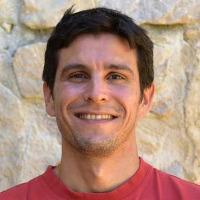BENJAMIN PARDO

Chef d'équipe
Chercheur
CNRS
0434359943
envoyer un message

Curriculum Vitae
Docteur ès Sciences (Biologie), Habilité à Diriger des Recherches (HDR)
Chargé de recherche classe normale, CNRS. Institut de Génétique Humaine UMR 9002 CNRS et Université de Montpellier, équipe « Maintien de l’intégrité du génome au cours de la réplication » dirigée par le Dr. Philippe Pasero.
CURSUS ACADEMIQUE
2021 Université de Montpellier. Habilitation à Diriger des Recherches (HDR). "étude des mécanismes de la réparation de l'ADN et de la stabilité du génome"
2003 -2006 Université PARIS XI. Thèse de doctorat, "étude de la protection de l’intégrité des télomères chez la levure Saccharomyces cerevisiae"
1998-2003 Université PARIX XI. DEUG, Licence+Maîtrise+D.E.A. (Magistère de Biotechnologies)
EXPERIENCE DE RECHERCHE
2014-présent recrutement CR2 au CNRS dans l’équipe « Maintien de l’intégrité du génome au cours de la réplication » dirigée par le Dr. Philippe Pasero (Institut de Génétique Humaine, Montpellier, France).
Projet : étude des mécanismes de réparation et de signalisation des dommages à l’ADN pendant la phase S chez la levure Saccharomyces cerevisiae.
2012-2014 2ème stage post-doctoral dans l’équipe « Maintien de l’intégrité du génome au cours de la réplication » dirigée par le Dr. Philippe Pasero (Institut de Génétique Humaine, Montpellier, France).
Projet : étude du redémarrage des fourches des réplication de l’ADN par le mécanisme de recombinaison homologuechez la levure Saccharomyces cerevisiae.
2007-2012 1er stage post-doctoral dans l’équipe « Genome stability & Cancer » dirigée par le Pr. Andrés Aguilera (Centro Andaluz de Biologia Molecular y Medicina Regenerativa, Séville, Espagne).
Projet : étude de l'implication des mécanismes de réparation des cassures double-brin de l'ADN dans la formation des translocations chromosomiques chez la levure Saccharomyces cerevisiae.
2002-2007 D.E.A. et Thèse de doctorat dans l’équipe « Télomères et réparation de l’ADN » dirigée par le Dr. Stéphane Marcand (Commissariat à l’Energie Atomique, Fontenay aux Roses, France).
Projet : étude de la protection de l’intégrité des télomères chez la levure Saccharomyces cerevisiae.
2002 Stage obligatoire de Maîtrise (6 mois) dans l’équipe du Pr. Léa Brakier-Gingras (Université de Montréal, Canada).
Projet : étude des protéines ribosomiques chez la bactérie Escherichia coli.
2001 Stage facultatif (2 mois) dans l’équipe du Pr. Patrick Forterre (Institut de Génétique et Microbiologie, Université Paris XI, Orsay).
Projet : étude de l’ADN topoisomérase VI chez les archées.
2000 Stage facultatif (2 mois) dans l’équipe du Pr. Philippe Silar (Institut de Génétique et Microbiologie, Université Paris XI, Orsay).
Projet : étude des éléments infectieux non-conventionnels chez le champignon Podospora anserina.
FINANCEMENTS OBTENUS
2020 Porteur d’un projet Fondation ARC (Fondation ARC pour la Recherche contre le Cancer, 2 ans). La dotation est de 50 k€.
2019 Contributeur à l’obtention de l’ANR PRC « ReDeFINe » (Ministère Français de la Recherche, 4 ans). La dotation est de 140 k€.
2017 Contributeur à l’obtention de l’ANR PRC « GeMaPer » (Ministère Français de la Recherche, 5 ans. La dotation est de 174 k€.
2013 Contrat de financement post-doctoral de la FRM (Fondation pour la Recherche Médicale, 2 ans). La dotation est de 110 k€.
2010 Contrat de financement post-doctoral « Juan de la Cierva » (Ministère Espagnol de la Recherche, 2 ans). La dotation est de 39 k€.
2007 Contrat de financement post-doctoral EMBO Long-term Fellowship (European Molecular Biology Organization, 2 ans). La dotation est de 48 k€.
LISTE DES PUBLICATIONS
Reusswig K-U, Bittmann J, Peritore M, Courtes M, Pardo B, Wierer M, Mann M & Pfander B. (2022) Unscheduled DNA replication in G1 causes genome instability and damage signatures indicative of replication collisions. Nature Communications 13:7014.
Ovejero S, Kumanski S, Soulet C, Azarli J, Pardo B, Santt O, Constantinou A, Pasero P & Moriel Carretero M. (2022) A Sterol-PI(4)P exchanger controls the Tel1/ATM axis of the DNA Damage Response. bioRxiv 2022.07.13.499867
Pourali P, Pasero P & Pardo B $ (2022) Top1p targeting by Fob1p at the ribosomal Replication Fork Barrier does not account for camptothecin sensitivity in Saccharomyces cerevisiae cells. microPublication Biol 2022
$ Corresponding author
Coiffard J, Santt O, Kumanski S, Pardo B $ & Moriel-Carretero M $. (2021). A CRISPR-Cas9-based system for the dose-dependent study of DNA double strand breaks sensing and repair. bioRxiv
2021.10.21.465387; doi: https://doi.org/10.1101/2021.10.21.465387
$ Corresponding authors
Pardo B $, Moriel-Carretero M, Vicat T, Aguilera A $ & Pasero P. (2020) A new role of the Mus81 endonuclease for replication completion after fork restart. EMBO Reports 21(7):e49367.
$ Corresponding authors
Forey R, Poveda A, Sharma S, I Padioleau, Renard C, Lambert R, Skrypczak M, Ginalski K, A Lengronne A, Chabes A, Pardo B $ & Pasero P $. (2020) Mec1 is activated at the onset of normal S phase by low dNTP pools impeding DNA replication. Molecular Cell78(3):396-410.e4.
$ Corresponding authors
Voordeckers K, Colding C, Grasso L, Pardo B, Hoes L, Kominek J, Gielens K, Van Loo P, Nuyts S, Pasero P, Lisby M & Verstrepen KJ. (2020) Ethanol exposure increases mutation rate through error-prone polymerases. Nature Communications 11(1):3664.
Zhu Y, Biernacka A, Pardo B, Dojer N, Forey R, Skrzypczak M, Fongang B, Nde J, Yousefi R, Pasero P, Ginalski K & Rowicka M. (2019) qDSB-Seq is a general method for genome-wide quantification of DNA double-strand breaks using sequencing. NatureCommunications 10(1):2313.
Moriel-Carretero M, Pasero P & Pardo B $. (2018) DRC Inc. One business, two associates. Current Genetics, 10.1007/s00294-018-0908-7.
$ Corresponding author
Biernacka #, A., Zhu Y #, Skrypczak M, Forey R, Pardo B, Grzelak M, Nde J, Mitra A, Kudlicki A, Crosetto N, Pasero P, Rowicka M & Ginalski K. (2018) i-BLESS is an ultra-sensitive method for detection of DNA double-strand breaks, Communications Biology 1:181.
# contribution égale
Bacal J #, Moriel-Carretero M #, Pardo B, Barthe A, Sharma S, Chabes A, Lengronne A & Pasero P. (2018) Mrc1 and Rad9 cooperate to regulate initiation and elongation of DNA replication in response to DNA damage, The EMBO Journal 37(21).
# contribution égale
Muñoz-Galvan S, Garcia-Rubio M, Ortega P, Ruiz JF, Jimeno S, Pardo B, Gomez-Gonzalez B & Aguilera A. (2017) A new role for Rrm3 in repair of replication-born DNA breakage by sister-chromatid recombination, PLoS Genetics 13(5):e1006781.
Pardo, B., Crabbe, L. & Pasero, P. (2017) Signaling pathways of replication stress in yeast, Fems Yeast Research 1; 17(2).
Ruiz JF #, Pardo B #, Sastre-Moreno G, Aguilera A & Blanco L. (2013) Yeast Pol4 promotes Tel1-regulated chromosomal translocations, PLoS Genetics 9(7):e1003656.
# contribution égale
Pardo B & Aguilera A. (2012) Complex chromosomal rearrangements mediated by break-induced replication and half-crossovers involve structure-selective endonucleases, PLoS Genetics 8(9):e1002979.
Pardo B, Gomez-Gonzalez B & Aguilera A. (2009) DNA repair in mammalian cells: DNA double-strand break repair: how to fix a broken relationship, Cellular & Molecular Life Sciences 66, 1039-56.
Marcand S, Pardo B, Gratias A, Cahun S & Callebaut I (2008) Multiple pathways inhibit NHEJ at telomeres, Genes & Development 22, 1153-8.
Pardo B, Ma E & Marcand S. (2006) Mismatch tolerance by DNA polymerase Pol4 in the course of nonhomologous end joining in Saccharomyces cerevisiae, Genetics 172, 2689-94.
Pardo B & Marcand S. (2005) Rap1 prevents telomere fusions by nonhomologous end joining, The EMBO Journal 24 (17), 3117-27.
COMMUNICATIONS SCIENTIFIQUES
2022 EMBO meeting “The DNA damage response in Physiology and Disease”, Sounio, Grèce.
Poster: “Coordination between the S-phase checkpoint regulation and replication fork repair by Fun30 and Slx4”.
Congrès “3R : Réplication, Recombinaison & Réparation”, Giens, France.
Poster: “DNA damage-induced Transcription/Replication conflicts are at the basis of the cytotoxicity of the antitumoral drug camptothecin”.
2020 Congrès “5th French-German DNA Repair Meeting”, Montpellier, France.
Présentation orale: “Homologous recombination and Mus81 promote replication completion in response to replication blockage”
Congrès “Trends in Genome Integrity and Genome Dynamics”, Seville, Espagne.
Poster: “Mec1ATR is activated at the onset of S phase by low dNTP pools impeding DNA replication”
2019 Congrès “EMBO YIP Sectoral meeting on Genome Integrity”, Zurich, Suisse.
Présentation orale: “Kinetics of the checkpoint response to replication stress”
Congrès “3R : Réplication, Recombinaison & Réparation”, Giens, France.
Poster: “Mec1 is activated at the onset of normal S phase by low dNTP pools impeding DNA replication”
2018 Réunion “Club Noyau”, Paris, France.
Présentation orale: “Yeast cells require endogenous stress to carry out DNA replication”
Congrès “FASEB Dynamic DNA Structures in Biology”, Olean, U.S.A.
Présentation orale: “Checkpoint control of endogenous replication stress”
2017 Congrès “EMBO YIP Sectoral meeting on Genome Integrity”, Heraklion, Greece.
Présentation orale: “The replication checkpoint is activated during an unchallenged S phase: why and what for?”
Congrès “3R : Réplication, Recombinaison & Réparation”, Giens, France.
Poster: “Repair and Signaling of Camptothecin-induced DNA damage”

